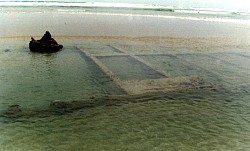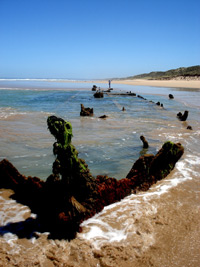|
||||||||||||
|
|
||||||||||||
|
|
The Magnat was built in Sunderland, England in 1885 by S.P. Austin and Sons and originally named the Edward Pembroke. The vessel was a 1120-ton, three masted iron barque, with dimensions 206 x 33.5 x 19.2 feet, and was said to be a reasonably flat bottomed vessel.
After his release, Captain Ostermann returned to Germany and he, along with C. Fehsenfeldt of Bremen, purchased the Edward Pembroke. This vessel, when renamed Magnat, made its first voyage under her new owners taking a load of timber from Norway to Capetown. There it remained in ballast for several months before leaving on its last voyage with Captain Ostermann and a crew of 17. The Magnat was to sail in ballast from Capetown to Newcastle were it was to load coal for Valparaiso, Chile. The Magnat had an easy voyage until forty days out from Capetown, when on 8 May 1900, a storm was encountered by the vessel at 4 am as it entered Bass Strait. Captain Ostermann set a new course as they passed King Island at noon, and soon after midnight when land was sighted and rollers heard, they realised that something had gone drastically wrong. Full sail was set and the crew tried to save the vessel, but being in ballast, the Magnat was too light and would not answer her helm and went ashore at 2 am May 9. The Magnat was 32 miles off its course, and when it struck the beach at Tarwin Lower, Captain Ostermann blamed the tide, stating that it must have carried him that far off coarse in 20 hours. The Magnat went ashore broadside on to the sandy beach with no injury or loss of life.
The next morning when the wreck was found by some local stockmen, the crew were armed with knives, terrified that the aborigines were lurking nearby. The wreck was then reported to Constable Thyer of Inverloch, who visited the site later that day. On his arrival at the Magnat, Constable Thyer stated that the vessel had already settled about six feet into the sand and was sitting perfectly upright with the bow facing Cape Liptrap. He then went aboard via a block and tackle set up by the crew and interviewed the captain on the details regarding the loss. On his return to the shore the constable was nearly drowned when the block and tackle came loose and he was dropped into the sea. The following day the steamer Lady Loch arrived with the Queenscliff life boat in tow. Captain Livingstone of the Lady Loch consulted with the superintendent of the life boat on what could be done. However, the Magnat was too high up on the beach and the steamer could not get anywhere near the wreck, as for nearly a half mile out to sea, the water was no more than four feet deep. With nothing that could be done, and the crew in no danger, the steamer headed for home. Newspaper reporters and locals began to visit the site of the wreck, the captain and crew stayed aboard the Magnat and they ordered supplies from the local hotel owner, Mr Munro. Captain Ostermann spoke to the reporters along with his first mate M. Peters and second mate D. Braue, these being the only crew that could speak English. They reported on the details of the disaster, and how lucky they were. An interesting point was that Captain Ostermann stated that this was the first time that he had ever sailed the east coast of Victoria. He said that he had visited Melbourne many times but had only come and gone via the west coast. The first mate M. Peters had also visited Australia many times but had only ever come around the bottom of Tasmania to get to the east - he had never come through Bass Strait. Captain Osterinann was also asked by a reporter if this was the first time he had ever lost a vessel, to which he replied he had not. We now know this not to be the case.
Now with the vessel a total loss, the Captain and crew stayed aboard and began to remove valuables and personal belongings. After becoming ill, said to be caused by worry, Captain Ostermann died on the ship on August 20, 1900. He was buried in the cemetery at Tarwin Lower. The remaining crew of the Magnat, I presume, were sent home. They consisted of first mate M. Peters, second mate D. Braue, T. Hilt, F. Hevne, H. Hennings, G. Schildt, A. Hirsted, T. Leonhardt, 0. Barrels, H. Meyers, W. Arndt, A. Eeklamd, K. Strackil, F. Hancker, B. Willsen, T. Meyers and E.Ericksen.
The wreck of the Helen, a small wooden vessel, lies about two hundred metres inshore from the bow of the Magnat. The Helen was stolen by convicts in Tasmania and run ashore at Tarwin in the 1850s. George Black, the local property owner, was fearful that these men might steal some of his stock, so he burnt the vessel. The Helen was last visible in 1923 but since has been covered by the sand dunes. The MAAV has visited the Magnat on a number of occasions, but it is a project far from completion. We would still like to produce a site plan and try to locate more artefacts scattered throughout the region.
References
Written permission from the M.A.A.V. is required for the publication of any material. Any use of this material should credit the Maritime Archaeology Association Of Victoria.
Last modified: April, 2011 |
|||||||||||




